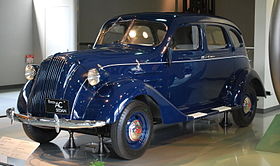Toyota A1
| A1 | |
|---|---|
| Overview | |
| Manufacturer | Toyota |
| Production | 1935 (3 prototypes) |
| Assembly | Koromo, Japan |
| Body and chassis | |
| Class | medium size family car |
| Body style | sedan |
| Layout | FR layout |
| Related | Toyota G1 |
| Powertrain | |
| Engine | 3.4L Type A I6 |
| Transmission | 3-speed manual |
| Chronology | |
| Successor | Toyota AA |
| Toyota AA, Toyota AB | |
|---|---|
 |
|
| Overview | |
| Manufacturer | Toyota |
| Production | 1936–1943 |
| Assembly | Koromo, Japan |
| Body and chassis | |
| Class | Mid-size car |
| Body style | 4-door sedan (AA) 4-door convertible (AB) |
| Layout | Front-engine, rear-wheel-drive |
| Related | Toyota Classic |
| Powertrain | |
| Engine | 3.4L Type A I6 |
| Transmission | 3-speed manual |
| Dimensions | |
| Wheelbase | 2,851 mm (112.2 in) |
| Length | 4,737 mm (186.5 in) |
| Width | 1,734 mm (68.3 in) |
| Height | 1,737 mm (68.4 in) |
| Curb weight | 1,500 kg (3,307 lb) |
| Chronology | |
| Predecessor | Toyota A1 |
| Successor | Toyota AC |
| AC | |
|---|---|
 |
|
| Overview | |
| Manufacturer | Toyota |
| Production | 1943–1944, 1947-1948 |
| Body and chassis | |
| Class | Medium size family car |
| Body style | 4-door sedan |
| Layout | FR layout |
| Powertrain | |
| Engine | 3.4L Type B I6 |
| Transmission | 3-speed manual |
| Dimensions | |
| Wheelbase | 2,850 mm (112.2 in) |
| Length | 4,884 mm (192.3 in) |
| Width | 1,734 mm (68.3 in) |
| Height | 1,746 mm (68.7 in) |
| Curb weight | 1,550 kg (3,417.2 lb) |
| Chronology | |
| Predecessor | Toyota AA & AB |
| Successor | Toyota SA |
| EA | |
|---|---|
| Overview | |
| Manufacturer | Toyota |
| Production | 1938 (prototypes) |
| Assembly | Koromo, Japan |
| Body and chassis | |
| Class | Subcompact family car |
| Body style | 2-door saloon |
| Layout | FF layout |
| Related | DKW F7 |
| Powertrain | |
| Engine | 585 cc Type E I2 two-stroke |
| Dimensions | |
| Wheelbase | 2,610 mm (102.8 in) |
| Length | 3,220 mm (126.8 in) |
| Width | 1,300 mm (51.2 in) |
| Height | 1,250 mm (49.2 in) |
| Curb weight | 650 kg (1,433 lb) |
| AE | |
|---|---|
| Overview | |
| Manufacturer | Toyota |
| Production | 1941–1943 |
| Body and chassis | |
| Class | medium size family car |
| Body style | sedan |
| Layout | FR layout |
| Powertrain | |
| Engine | 2.3L Type C I4 |
| Transmission | 3-speed manual |
| Dimensions | |
| Wheelbase | 2,500 mm (98.4 in) |
| Length | 4,500 mm (177.2 in) |
| Width | 1,730 mm (68.1 in) |
| Height | 1,635 mm (64.4 in) |
| Curb weight | 1,220 kg (2,689.6 lb) |
| Chronology | |
| Predecessor | AA, AB |
| Successor | AC |
The A1 was the first prototype passenger car built by the company that became Toyota. It was redesigned and put into production as Toyota's first production cars, the AA sedan and the AB cabriolet. These were succeeded by the similar AE, AC and BA sedans.
The series as a whole was replaced by the quite different and much more advanced SA.
Three A1 prototypes were completed in May 1935. None of them survive. They were blessed in a Buddhist ceremony and Kiichiro Toyoda then drove one of them to his father's grave (his father having given him the seed money to start a car factory).
After completion of the prototypes, Toyota then switched its attention to the G1 truck because it was more likely to be profitable in the short term. After the G1 was in production the company was able to spend resources on developing the AA and AB passenger cars.
The A1 prototypes were completed in May 1935.
The A1 used the 3389 cc Type A 6-cylinder engine producing 62 horsepower (46 kW) with a 3-speed column-shift manual gearbox.
The Type A engine was copied from Chevrolet, and the chassis and electrics were copied from Ford.
Solid axles were used at both ends. Pressed metal discs were used for all 4 wheel rims (very modern for the time). Braking was by drums.
The mechanicals were the same as used in the production AA, AB and G1 vehicles.
The A1 was a fully enclosed, 4-door sedan, with normal front doors and forward-opening suicide-style rear doors. It was heavily based on the Chrysler built DeSoto Airflow; Toyoda bought an Airflow and disassembled it the year before producing the A1. The front window was a single piece of flat glass with a top-mounted wiper on the driver's side. There were 3 windows per side, one for the front door (without a quarter light window), one for the rear door and one behind the rear door. A spare tyre was mounted on the nearly vertical boot lid.
...
Wikipedia
